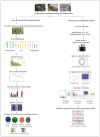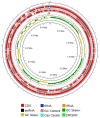Characterization and Molecular Insights of a Chromium-Reducing Bacterium Bacillus tropicus
- PMID: 39770835
- PMCID: PMC11676387
- DOI: 10.3390/microorganisms12122633
Characterization and Molecular Insights of a Chromium-Reducing Bacterium Bacillus tropicus
Abstract
Environmental pollution from metal toxicity is a widespread concern. Certain bacteria hold promise for bioremediation via the conversion of toxic chromium compounds into less harmful forms, promoting environmental cleanup. In this study, we report the isolation and detailed characterization of a highly chromium-tolerant bacterium, Bacillus tropicus CRB14. The isolate is capable of growing on 5000 mg/L Cr (VI) in an LB (Luria Bertani) agar plate while on 900 mg/L Cr (VI) in LB broth. It shows an 86.57% reduction ability in 96 h of culture. It can also tolerate high levels of As, Cd, Co, Fe, Zn, and Pb. The isolate also shows plant growth-promoting potential as demonstrated by a significant activity of nitrogen fixation, phosphate solubilization, IAA (indole acetic acid), and siderophore production. Whole-genome sequencing revealed that the isolate lacks Cr resistance genes in their plasmids and are located on its chromosome. The presence of the chrA gene points towards Cr(VI) transport, while the absence of ycnD suggests alternative reduction pathways. The genome harbors features like genomic islands and CRISPR-Cas systems, potentially aiding adaptation and defense. Analysis suggests robust metabolic pathways, potentially involved in Cr detoxification. Notably, genes for siderophore and NRP-metallophore production were identified. Whole-genome sequencing data also provides the basis for molecular validation of various genes. Findings from this study highlight the potential application of Bacillus tropicus CRB14 for bioremediation while plant growth promotion can be utilized as an added benefit.
Keywords: Bacillus tropicus; bioremediation; chromium-reducing bacteria; heavy metal tolerant; whole-genome sequencing.
Conflict of interest statement
The authors declare no conflicts of interest.
Figures










Similar articles
-
Tolerance and Reduction of Chromium(VI) by Bacillus sp. MNU16 Isolated from Contaminated Coal Mining Soil.Front Plant Sci. 2017 May 22;8:778. doi: 10.3389/fpls.2017.00778. eCollection 2017. Front Plant Sci. 2017. PMID: 28588589 Free PMC article.
-
Chromium reduction, plant growth-promoting potentials, and metal solubilizatrion by Bacillus sp. isolated from alluvial soil.Curr Microbiol. 2007 Mar;54(3):237-43. doi: 10.1007/s00284-006-0451-5. Curr Microbiol. 2007. PMID: 17294325
-
Reclamation of chromium-contaminated soil by native Cr(VI)-reducing and PHA-accumulating Bacillus aryabhattai CTSI-07.Int Microbiol. 2024 Jun;27(3):731-742. doi: 10.1007/s10123-023-00421-6. Epub 2023 Sep 7. Int Microbiol. 2024. PMID: 37676443
-
Metabolic pathway of Cr(VI) reduction by bacteria: A review.Microbiol Res. 2023 Mar;268:127288. doi: 10.1016/j.micres.2022.127288. Epub 2022 Dec 18. Microbiol Res. 2023. PMID: 36571921 Review.
-
Microbial innovations in chromium remediation: mechanistic insights and diverse applications.World J Microbiol Biotechnol. 2024 Mar 30;40(5):151. doi: 10.1007/s11274-024-03936-w. World J Microbiol Biotechnol. 2024. PMID: 38553582 Review.
References
-
- Khatun J., Mukherjee A., Dhak D. Emerging Contaminants of Tannery Sludge and Their Environmental Impact and Health Hazards. In: Kumar V., Bhat S.A., Kumar S., Verma P., editors. Environmental Engineering and Waste Management. Springer Nature; Cham, Switzerland: 2024. pp. 3–28. - DOI
-
- Ahamed N., Kashif P.M. Safety disposal of tannery effluent sludge: Challenges to researchers-a review. Int. J. Pharma Sci. Res. 2014;5:733–736.
LinkOut - more resources
Full Text Sources
Research Materials
Miscellaneous

